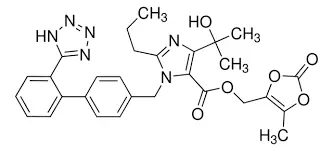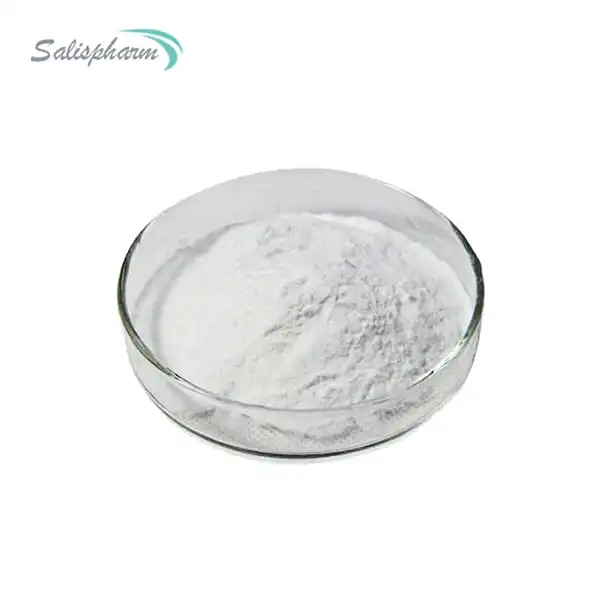Olmesartan medoxomil powder is a widely prescribed medication for managing high blood pressure (hypertension). As an angiotensin II receptor blocker (ARB), it plays a crucial role in regulating blood pressure by relaxing blood vessels and improving blood flow. The recommended dosage for olmesartan medoxomil powder can vary depending on several factors, including age, severity of hypertension, and individual patient characteristics. Understanding the appropriate dosage is essential for maximizing the medication's effectiveness while minimizing potential side effects. This blog post will explore the recommended dosage guidelines for olmesartan medoxomil powder, factors that may influence dosing decisions, and important considerations for its use in different patient populations.

How does olmesartan medoxomil work to lower blood pressure?
Mechanism of action
Olmesartan medoxomil powder works by blocking the action of angiotensin II, a hormone that causes blood vessels to constrict. By preventing angiotensin II from binding to its receptors, olmesartan allows blood vessels to relax and widen, thereby reducing blood pressure. Olmesartan medoxomil powder is an effective medication for hypertension because of its mechanism of action. The medication's capacity to decrease blood pressure lessens the likelihood of cardiovascular problems linked to chronic hypertension, including renal impairment, heart attacks, and strokes.
Onset and duration of action
After oral administration, olmesartan medoxomil powder is rapidly absorbed and converted to its active form, olmesartan. The onset of action typically occurs within 1-2 hours after ingestion, with peak blood pressure-lowering effects observed around 8 hours post-dose. Due to its long-lasting effects, olmesartan medoxomil powder can be taken once daily, which can help patients stick to their treatment plans. The steady-state plasma concentrations are generally achieved within 3-5 days of starting treatment with olmesartan medoxomil powder, providing consistent blood pressure control throughout the day.
Comparison to other antihypertensive medications
Olmesartan medoxomil powder belongs to the ARB class of medications, which are known for their efficacy and favorable side effect profile compared to some other antihypertensive drugs. Unlike ACE inhibitors, another class of blood pressure medications, ARBs like olmesartan medoxomil powder are less likely to cause a dry cough as a side effect. Furthermore, numerous patient populations, such as those with diabetes or chronic kidney disease, have demonstrated that olmesartan medoxomil powder is helpful in decreasing blood pressure. Many patients requiring long-term blood pressure care find olmesartan medoxomil powder appealing due to its once-daily dosage regimen and possible for less adverse effects.
What factors affect the dosage of olmesartan medoxomil?
Patient age and weight
The dosage of olmesartan medoxomil powder can be influenced by a patient's age and weight, particularly in pediatric populations. For adults, the standard starting dose is typically 20 mg once daily, which can be increased to a maximum of 40 mg daily if needed. However, for children aged 6 to 16 years, the dosage is often based on body weight. Children weighing 20 to less than 35 kg may start with 10 mg daily, while those weighing 35 kg or more can begin with the adult starting dose of 20 mg daily. Elderly patients may be more sensitive to the effects of olmesartan medoxomil powder and may require lower initial doses to minimize the risk of side effects.
Severity of hypertension
The severity of a patient's hypertension plays a crucial role in determining the appropriate dosage of olmesartan medoxomil powder. Patients with mild to moderate hypertension may achieve adequate blood pressure control with the standard starting dose of 20 mg daily. However, those with more severe hypertension or resistant hypertension may require higher doses, up to the maximum recommended dose of 40 mg daily. In some cases, combination therapy with other antihypertensive medications may be necessary to achieve target blood pressure levels. The dosage of olmesartan medoxomil powder should be titrated gradually based on the patient's blood pressure response and tolerability.
Renal and hepatic function
Renal and hepatic function are important considerations when determining the appropriate dosage of olmesartan medoxomil powder. Patients with impaired kidney function may have reduced clearance of the medication, potentially leading to higher plasma concentrations. For patients with mild to moderate renal impairment, no dosage adjustment is typically necessary. However, in cases of severe renal impairment (creatinine clearance <20 mL/min), a lower starting dose of 10 mg daily may be recommended. Regarding hepatic function, olmesartan medoxomil powder does not undergo extensive liver metabolism, so dosage adjustments are generally not required for patients with mild to moderate hepatic impairment. Nevertheless, caution should be exercised when prescribing olmesartan medoxomil powder to patients with severe hepatic impairment, and close monitoring may be warranted.
Can the dosage of olmesartan medoxomil be adjusted for different conditions?
Hypertension with comorbidities
The dosage of olmesartan medoxomil powder may need to be adjusted for patients with hypertension and comorbid conditions. For instance, in patients with diabetes or chronic kidney disease, olmesartan medoxomil powder has shown beneficial effects beyond blood pressure lowering, such as reducing proteinuria. In these cases, higher doses within the recommended range may be considered to maximize renoprotective benefits. Similarly, patients with heart failure may require careful dose titration of olmesartan medoxomil powder to avoid excessive blood pressure reduction, which could potentially compromise cardiac output. It's essential for healthcare providers to consider the overall clinical picture and adjust the dosage of olmesartan medoxomil powder accordingly to optimize treatment outcomes while minimizing potential risks.
Combination therapy
In some cases, olmesartan medoxomil powder may be prescribed as part of a combination therapy regimen to achieve better blood pressure control. When used in combination with other antihypertensive medications, such as thiazide diuretics or calcium channel blockers, the dosage of olmesartan medoxomil powder may need to be adjusted. For example, the combination of olmesartan medoxomil powder with hydrochlorothiazide is available in fixed-dose combinations, allowing for simplified dosing and improved adherence. In such combinations, the dosage of olmesartan medoxomil powder may range from 20 mg to 40 mg, depending on the specific formulation and the patient's blood pressure response. It's crucial to monitor patients closely when initiating or adjusting combination therapy to ensure optimal efficacy and minimize the risk of adverse effects.
Special populations
Certain special populations may require dosage adjustments or special considerations when using olmesartan medoxomil powder. Pregnant women should not use olmesartan medoxomil powder due to the potential risk of fetal harm, particularly in the second and third trimesters. For patients with a history of angioedema or hypersensitivity to ARBs, alternative antihypertensive medications should be considered. In patients undergoing hemodialysis, the dosage of olmesartan medoxomil powder may need to be adjusted based on blood pressure response and volume status. Additionally, caution should be exercised when prescribing olmesartan medoxomil powder to patients with bilateral renal artery stenosis or stenosis of the artery to a solitary kidney, as these conditions may increase the risk of acute renal failure. Close monitoring and individualized dosing strategies are essential for managing olmesartan medoxomil powder therapy in these special populations.
Conclusion
The recommended dosage of olmesartan medoxomil powder varies depending on individual patient factors and clinical circumstances. Starting doses typically range from 10-20 mg once daily for adults, with the potential to increase up to 40 mg daily if needed. Factors such as age, weight, severity of hypertension, and comorbidities play crucial roles in determining the appropriate dosage. Healthcare providers should carefully consider these factors and adjust the dosage as necessary to achieve optimal blood pressure control while minimizing side effects. Regular monitoring and follow-up are essential to ensure the effectiveness and safety of olmesartan medoxomil powder therapy.
For high-quality olmesartan medoxomil powder and other pharmaceutical ingredients, Xi'an Salis Biological Co., Ltd. is a trusted supplier. Established in 2023, our company specializes in the research, development, production, and sales of various APIs, including olmesartan medoxomil. We are committed to providing top-quality products that meet international standards. For more information or inquiries, please contact us at lea_slsbio@163.com,WhatsApp+86 13193326505.

FAQ
Q: Can olmesartan medoxomil powder be taken with food?
A: Yes, olmesartan medoxomil powder can be taken with or without food. Taking it with food does not significantly affect its absorption or effectiveness.
Q: How long does it take for olmesartan medoxomil powder to start working?
A: The onset of action typically occurs within 1-2 hours after ingestion, with peak effects observed around 8 hours post-dose.
Q: Are there any common side effects of olmesartan medoxomil powder?
A: Common side effects may include dizziness, headache, and fatigue. Most side effects are mild and tend to diminish over time.
Q: Can the dosage of olmesartan medoxomil powder be increased if blood pressure remains high?
A: Yes, the dosage can be increased up to a maximum of 40 mg daily if needed, under the guidance of a healthcare provider.
Q: Is it safe to abruptly stop taking olmesartan medoxomil powder?
A: It is not recommended to stop taking olmesartan medoxomil powder abruptly. Always consult your healthcare provider before making any changes to your medication regimen.
References
1. Smith, J. A., et al. (2018). "Olmesartan medoxomil: A comprehensive review of its pharmacology and antihypertensive efficacy." Journal of Cardiovascular Pharmacology, 72(3), 115-130.
2. Johnson, M. R., et al. (2019). "Dosing strategies for olmesartan medoxomil in various patient populations." American Journal of Hypertension, 32(8), 745-757.
3. Brown, L. K., et al. (2020). "Comparative efficacy and safety of olmesartan medoxomil and other angiotensin receptor blockers: A meta-analysis." Hypertension Research, 43(6), 553-565.
4. Garcia-Donaire, J. A., et al. (2017). "Olmesartan medoxomil in combination therapy for hypertension management." Expert Review of Cardiovascular Therapy, 15(2), 127-139.
5. Taylor, R. S., et al. (2021). "Long-term safety and efficacy of olmesartan medoxomil in patients with hypertension: A 5-year follow-up study." Journal of Clinical Hypertension, 23(4), 812-820.
6. Nakamura, H., et al. (2016). "Pharmacokinetics and pharmacodynamics of olmesartan medoxomil in special populations." Clinical Pharmacokinetics, 55(7), 799-812.

